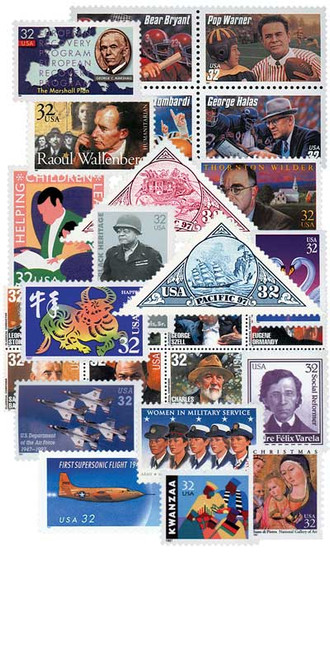
# 3175 - 1997 32c Kwanzaa
US #3175
1997 Kwanzaa – Holiday Celebration Series
- First US stamp honoring Kwanzaa
- Second stamp in the Holiday Celebration Series
Stamp Category: Commemorative
Series: Holiday Celebration
Value: 32¢, First Class Mail Rate
First Day of Issue: October 22, 1997
First Day City: Los Angeles, California
Quantity Issued: 133,000,000
Printed by: Avery Dennison Security Printing Division
Printing Method: Photogravure
Format: Panes of 50 (Horizontal 5 across, 10 down)
Perforations: 11.1 (die-cut simulated perforations that penetrate backing paper – backing paper on each stamp has horizontal die cut to facilitate its removal)
Tagging: Phosphored paper
Why the stamp was issued: To commemorate the African-American festival of Kwanzaa.
About the stamp design: Pictures artwork by Synthia Saint James, author of The Gifts of Kwanzaa. Saint James did a simple, posterlike illustration for the stamp showing a man, woman, and three children in traditional African attire. The symbols of Kwanzaa are also pictured: a straw mat, candleholder with seven candles, bowl of fruit and ears of corn, unity cup, wrapped gifts, and a flag with three horizontal stripes (red, black, and green).
First Day City: The stamp’s First Day of Issue Ceremony was held in Los Angeles, California at the Natural History Museum of Los Angeles County. The event coincided with the opening of a new exhibit at the museum called “Africa: One Continent, Many Worlds.” Dr. Maulana Karenga (creator of the Kwanzaa holiday) was one of the guests in attendance.
About the Holiday Celebration Series: The USPS introduced the Holiday Celebration series in 1996 with a stamp honoring the Jewish festival, Hanukkah. The series commemorated a different cultural or religious holiday each year.
History the stamp represents: Kwanzaa is an African-American holiday which begins on December 26 and lasts for seven days. It is based on the traditional African harvest festival. The name Kwanzaa is taken from a phrase meaning “first fruits” in Swahili, an East African language.
Maulana Karenga, a professor of black studies and a black cultural leader, developed this holiday in 1966. With its synthesis of ancient African practices and African-American ideals and aspirations, Kwanzaa is a non-denominational spiritual celebration. It is seen as a time for the gathering of families, and for rededication to the seven principles of Nguzo Saba, a set of values as expressed by Karenga.
The Kwanzaa principles are Umoja (unity), Kujichagulia (self-determination), Ujima (collective work and responsibility), Ujamaa (cooperative economics), Nia (purpose), Kuumba (creativity), and Imani (faith). Each day of Kwanzaa is dedicated to one of these principles.
Each evening during the holiday, family members light one of the seven candles of the kinara, or candleholder, and then discuss that day’s principle. Often, participants exchange gifts. Near the end of the holiday, the community gathers for a feast called karamu, which may include performances, music, and dancing.
US #3175
1997 Kwanzaa – Holiday Celebration Series
- First US stamp honoring Kwanzaa
- Second stamp in the Holiday Celebration Series
Stamp Category: Commemorative
Series: Holiday Celebration
Value: 32¢, First Class Mail Rate
First Day of Issue: October 22, 1997
First Day City: Los Angeles, California
Quantity Issued: 133,000,000
Printed by: Avery Dennison Security Printing Division
Printing Method: Photogravure
Format: Panes of 50 (Horizontal 5 across, 10 down)
Perforations: 11.1 (die-cut simulated perforations that penetrate backing paper – backing paper on each stamp has horizontal die cut to facilitate its removal)
Tagging: Phosphored paper
Why the stamp was issued: To commemorate the African-American festival of Kwanzaa.
About the stamp design: Pictures artwork by Synthia Saint James, author of The Gifts of Kwanzaa. Saint James did a simple, posterlike illustration for the stamp showing a man, woman, and three children in traditional African attire. The symbols of Kwanzaa are also pictured: a straw mat, candleholder with seven candles, bowl of fruit and ears of corn, unity cup, wrapped gifts, and a flag with three horizontal stripes (red, black, and green).
First Day City: The stamp’s First Day of Issue Ceremony was held in Los Angeles, California at the Natural History Museum of Los Angeles County. The event coincided with the opening of a new exhibit at the museum called “Africa: One Continent, Many Worlds.” Dr. Maulana Karenga (creator of the Kwanzaa holiday) was one of the guests in attendance.
About the Holiday Celebration Series: The USPS introduced the Holiday Celebration series in 1996 with a stamp honoring the Jewish festival, Hanukkah. The series commemorated a different cultural or religious holiday each year.
History the stamp represents: Kwanzaa is an African-American holiday which begins on December 26 and lasts for seven days. It is based on the traditional African harvest festival. The name Kwanzaa is taken from a phrase meaning “first fruits” in Swahili, an East African language.
Maulana Karenga, a professor of black studies and a black cultural leader, developed this holiday in 1966. With its synthesis of ancient African practices and African-American ideals and aspirations, Kwanzaa is a non-denominational spiritual celebration. It is seen as a time for the gathering of families, and for rededication to the seven principles of Nguzo Saba, a set of values as expressed by Karenga.
The Kwanzaa principles are Umoja (unity), Kujichagulia (self-determination), Ujima (collective work and responsibility), Ujamaa (cooperative economics), Nia (purpose), Kuumba (creativity), and Imani (faith). Each day of Kwanzaa is dedicated to one of these principles.
Each evening during the holiday, family members light one of the seven candles of the kinara, or candleholder, and then discuss that day’s principle. Often, participants exchange gifts. Near the end of the holiday, the community gathers for a feast called karamu, which may include performances, music, and dancing.













